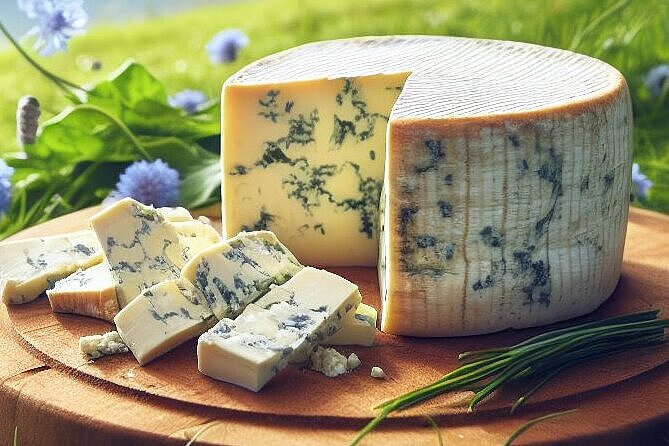Fourme d'Ambert

Do you love cheese and want to share it with your dog? Then you should definitely get to know Fourme d'Ambert, one of the mildest blue cheeses from France. In this article, you'll learn everything you need to know about this type of cheese: what Fourme d'Ambert is, how it is made, its advantages and disadvantages for dogs and the best way to feed it. Read on and be inspired!
What is Fourme d'Ambert?
Fourme d'Ambert is a French blue cheese from Auvergne, a region with extinct volcanoes and high plateaus. It is made from the milk of Salers cattle, which produce relatively little milk but are rich in fat. The name Fourme comes from the Latin word "forma", which means shape. The cheese has a cylindrical shape with a diameter of around 12 cm and a height of 19 cm. It weighs around 2 kg and has a dry, gray rind with orange spots. The dough is creamy and firm and has an ivory color with blue mold veins.
Fourme d'Ambert is one of the oldest cheeses in France. It has been produced since the 9th century and has been protected by the Appellation d'Origine Contrôlée (AOC) since 1972. This means that its quality is guaranteed and its production method is defined. It must be produced in a specific area around the town of Ambert and have a fat content of at least 50% in the dry matter. It is usually matured for two to five months and has a distinctly nutty and fruity flavor, with a creamy, mild taste when matured for a short time.
How is Fourme d'Ambert produced?
The production of Fourme d'Ambert is a traditional craft that requires a great deal of skill and experience. The milk is first pasteurized or thermized and then rennet is added to curdle it. The curd is cut into small pieces and placed in molds to drain. Similar to Roquefort, the cheese is first inoculated with a blue mold culture (Penicillium glaucum), which creates the characteristic mold veins.
After around 24 hours, the cheeses are removed from the molds and salted. They are then pricked several times with long needles to introduce air channels into the cheese paste. These allow the mould to spread inside the cheese and give it its typical aroma. The cheeses are then stored in special maturing cellars, where they are regularly turned and cared for. The optimum maturing time is between two and five months, depending on taste preference.
What are the benefits of Fourme d'Ambert for dogs?
Fourme d'Ambert is not only a delicious cheese for humans, but can also have some benefits for dogs. Cheese is a good source of protein, calcium, phosphorus, zinc and vitamin A, which are important for muscles, bones, skin and the immune system. Cheese also contains probiotic bacteria that can aid digestion.
Fourme d'Ambert is particularly mild and digestible for dogs as it has a low lactose content. Lactose is the milk sugar that some dogs cannot tolerate well. The maturing process breaks down the lactose in the cheese, making it easier to digest. Fourme d'Ambert also has a high fat content, which is an important source of energy for dogs. Fat also provides essential fatty acids, which are important for healthy skin and coat.
What are the disadvantages of Fourme d'Ambert for dogs?
Although Fourme d'Ambert is a healthy cheese, it should only be fed to dogs in moderation. Too much cheese can lead to obesity, bloating, diarrhea or vomiting. In addition, the high salt content in cheese can increase blood pressure and put a strain on the kidneys. Therefore, you should always make sure that your dog drinks enough water when it is given cheese.
Another disadvantage of Fourme d'Ambert is that it contains mold. Although mold is generally not harmful to dogs, some dogs can have an allergic reaction to it. In addition, in rare cases, mold can produce mycotoxins, which are toxic to dogs. Therefore, you should always make sure that the cheese is fresh and not spoiled. If the cheese has an unpleasant smell or taste or has changed color or consistency, you should no longer feed it to your dog.
How can Fourme d'Ambert be fed to dogs?
Fourme d'Ambert is a versatile cheese that can be fed to dogs in a variety of ways. For example, it can be used as a reward or treat by cutting off small pieces and giving them directly to the dog or mixing them into their food. It can also be used as an ingredient for homemade dog snacks by mixing it with flour, eggs and other ingredients to make a dough and baking small cookies.
Another option is to use Fourme d'Ambert as a flavor enhancer for regular dog food by melting it and pouring it over the food. This can be particularly useful if the dog doesn't like its food or eats it badly. You can also try creative recipes with Fourme d'Ambert, for example a salad with green leafy vegetables, boiled chicken and pieces of Fourme d'Ambert or a soup with potatoes, carrots and Fourme d'Ambert.
Fourme d'Ambert is a delicious cheese from France that can be enjoyed not only by humans but also by dogs. It has many health benefits for dogs, such as a high content of protein, calcium and probiotic bacteria. It is also mild and digestible for dogs as it contains little lactose. However, it should only be fed to dogs in small quantities, as it also contains a lot of fat and salt and can trigger mold allergies. You should also always make sure that the cheese is fresh and of good quality. If you pay attention to these points, you can enjoy Fourme d'Ambert as a tasty change in your dog's food.
If you notice any signs of hypersensitivity or poisoning in your dog, you should see your vet immediately. We are not a substitute for a vet, but we try to be as accurate as possible. Every dog reacts differently and we recommend you get a second opinion or consult your vet if in doubt.
Stay healthy and take good care of your four-legged friend!😊
Similar to Fourme d'Ambert
Roquefort is a cheese named after the village of Roquefort-sur-Soulzon in the south of France. It has a protected designation of origin, which means that it can only be produced in this region under...
Bleu d'Auvergne is a cheese made from raw or pasteurized cow's milk, which is mixed with blue mould cultures (Penicillium roqueforti). It is produced in round wheels weighing 2 to 3 kg, which are...
Gorgonzola is a soft cheese with at least 48% fat in dry matter that is produced in the Italian regions of Piedmont and Lombardy. It has a protected designation of origin and may only be produced in...
Stilton is a cheese that takes its name from the village of Stilton in Cambridgeshire, where it was first sold in the 18th century. However, it can only be produced in the counties of Derbyshire,...



